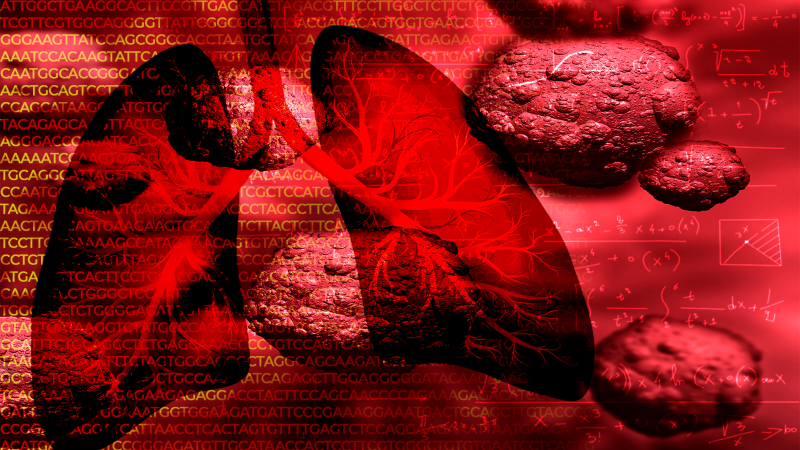
Cancer is an abnormal growth of a few cells that multiply faster than normal cells in the body. Sometimes these cells can merge to form a tumour. With the help of a double metamorphosis, called ‘metastasis’, cancer cells spread to other parts of the body even after treatment or therapy has successfully treated the tumour in the original place.
Cancer cells activate and spread driven by genetic instructions present in their DNA (Deoxyribonucleic acid). However, what exact genetic processes help them evade therapy is not entirely clear. Researchers from the Centre for BioSystems Science and Engineering, Indian Institute of Science (IISc), Bengaluru, have developed a mathematical method to identify the cause of therapy resistance in small cell lung cancer. This cancer, which originates in the lungs, is most likely caused by active or passive smoking or exposure to pollution, and is highly aggressive. The researchers demonstrated that all the genes in small cell lung cancer progression could be segregated into two groups, which usually nullify each other’s actions, but in some conditions also act in unison. These two groups, they argue, are responsible for therapy resistance of small cell lung cancer. The study, supported by the Department of Science and Technology, Government of India, was published in the journal eLife.
Cancer cells resemble two kinds of cells in the human body. One kind, called ‘epithelial cells’, form surfaces like skin and offer resistance to external pathogens, and can only co-exist in groups. The other type is ‘mesenchymal cells’, making up most of the body tissues such as blood and plasma. These cells can exist solitarily. Initial tumours of most cancer cells are primarily of the epithelial kind. However, as the tumor grows, some can metamorphose to mesenchymal cells, break off from the tumour, move to another part of the body, and then change back to epithelial cancer cells in the new location, thus completing what scientists call ‘metastasis’. Genetic instructions passed on by their DNA drives these actions.
The complete set of genes, known as the genome, is a complex architecture. It is a combination of multiple instructions targeted at various organs. For example, while one gene might reinforce the genetic instruction of a second gene, a third gene might want to nullify the effect. Thus, what genetic information passes on to different cells or tissues depends on how the genes collectively interact. There are, however, more than 20,000 genes. Understanding the genetic effect of the cancerous cells and their difference with normal cells remains a challenge.
Earlier researchers had identified 33 genes that are responsible for small cell lung cancer. They had also established the mutual effect of these genes, that is, which genes reinforce each other, which nullify the effect of others, and which pairs are independent. The experiments have also established 357 mutual interactions significant for small cell lung cancer. In the present study, the researchers from IISc focussed on the net effect of all these interactions. They set up these interactions into a mathematical ‘network’ –– a structure for defining all these interactions. They aimed to identify the genes that could express their instructions and those that failed to do so, as all operated in tandem.
After a small change is initiated by one gene, the genetic interactions reach an equilibrium. A cumulative set of genetic instructions passes on to cells and tissues depending on the final combination of active genes. Hence, the researchers studied how the network evolved with time. To do this, they wrote numerical codes to simulate the interaction on fast computers in IISc.
“However, the simulation takes too long to run, about seven days even on the fastest machines,” says Lakshya Chauhan, one of the authors of the study.
The limitation prompted the researchers to find a mathematical formula that could quantify the net effect of all genes. To do this, they considered not only the mutual interaction of the genes but whether a particular interaction was directly with another gene or via interactions with other genes.
“The longer the interaction path, the lesser is the net effect of the interaction on the full network,” explains Lakshya.
The researchers took this effect into account in the new mathematical quantity they defined. Then, they demonstrated that the quantity accurately predicts the evolution they had seen in the dynamic scenario.
“We were able to predict how genes interact with each other without having to run a dynamical simulation,” says Uday Ram, another author of the study.
The study predicts two groups of genes in the network, forming what the scientists identify as a switch. When one group of genes are active, the other group are not, and vice versa. Moreover, all the genes in a particular group reinforce each other’s instructions. This observation thus leads to the action of two distinct states of the entire network, in line with the epithelial and mesenchymal forms of cancer cells. Only one of the groups is active in the epithelial type of small cell lung cancer and the other in the mesenchymal type –– a remarkable simplification given that there are 33 genes with 357 mutual interactions responsible for small cell lung cancer.
Having identified the genes critical for the two groups, scientists can now attempt to stop the switching between the two types of cancerous cells, hence the metastasis. It would lead to targeted therapy of small cell lung cancer. However, developing a therapy is more complicated because deactivating a particular gene can affect the individual’s functioning as a whole. It might thus be more feasible to develop treatment targeted at affected individuals.
“Right now, our group is exploring the idea of binary grouping in other cancers,” Lakshya signs off.
This article has been run past the researchers, whose work is covered, to ensure accuracy.






